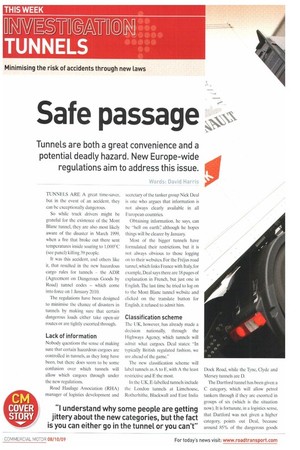Safe passage
Page 22

Page 23

If you've noticed an error in this article please click here to report it so we can fix it.
Tunnels are both a great convenience and a potential deadly hazard. New Europe-wide regulations aim to address this issue.
Words: David Harris
TUNNELS ARE A great time-saver, but in the event of an accident, they can be exceptionally dangerous So while truck drivers might be grateful for the existence of the Mont Blanc tunnel, they are also most likely aware of the disaster in March 1999. when a fire that broke out there sent temperatures inside soaring to 1,000'C (see panel) killing 39 people.
It was this accident, and others like it, that resulted in the new hazardous cargo rules for tunnels — the ADR (Agreement on Dangerous Goods by Road) tunnel codes — which come into force on 1 January 2010.
The regulations have been designed to minimise the chance of disasters in tunnels by making sure that certain dangerous loads either take open-air routes or are tightly escorted through.
Lack of information
Nobody questions the sense of making sure that certain hazardous cargoes are controlled in tunnels, as they long have been, but there does seem to be some confusion over which tunnels will allow which cargoes through under the new regulations.
Road Haulage Association (RHA) manager of logistics development and secretary of the tanker group Nick Deal is one who argues that information is not always clearly available in all European countries.
Obtaining information, he says, can be "hell on earth': although he hopes things will be clearer by January.
Most of the bigger tunnels have formulated their restrictions, hut it is not always obvious to those logging on to their websites. For the Frejus road tunnel, which links France with Italy, for example, Deal says there are 18 pages of explanation in French, but just one in English, The last time he tried to log on to the Mont Blanc tunnel website and clicked on the translate button for English, it refused to admit him.
Classification scheme
The UK, however, has already made a decision nationally, through the Highways Agency which tunnels will admit what cargoes. Deal states: "In typically British regulated fashion, we are ahead of the game."
The new classification scheme will label tunnels as A to E, with A the least restrictive and E the most.
In the UK, E-labelled tunnels include the London tunnels at Limehouse, Rotherhithe, Blackwall and East India Dock Road, while the Tyne, Clyde and Mersey tunnels are D.
The Dartford tunnel has been given a C category, which will allow petrol tankers through if they are escorted in groups of six (which is the situation now). It is fortunate, in a logistics sense, that Dartford was not given a higher category, points out Deal, because around 85% of the dangerous goods
vehicles going through Dartford are petrol tankers.
Deal says: "If Dartford had been classified as E, then it would have meant chaos on the roads and for petrol deliveries."
Their own rules
Individual tunnel operators can also add their own restrictions to those in the European code, for example, by restricting not just the types of vehicle they will allow through, but also the times during which certain types of cargo can be taken through. Deal says that the Frejus tunnel seems to be doing this for trucks carrying gas cylinders.
Despite the criticisms that not everything is yet clear, some hauliers that regularly carry hazardous cargo are relatively calm about the changes.
Ray Cook, director at Geodis, says that "there have been restrictions in tunnels for years': He adds: "I understand why some people are getting a bit jittery about the new categories, but the fact is you can either go in the tunnel or you can't — you just have to work with it."
Cook reveals that most of the major tunnels have already got the restrictions in place, and the hauliers that regularly carry hazardous cargo already know what can be taken into each tunnel.
However, he concedes that for some operators, things might be a little harder. He says: "If you don't do this sort of thing on a daily basis. I can see that it might be confusing. Ultimately, though, the new categories will be a good thing. It takes away any doubt about what you can carry through a tunnel."
A good thing
Chris McRae, the Freight Transport Association dangerous goods expert, says that the uniform approach should be, broadly, a good thing with common signage and common criteria, rather than 'having] different books for different tunnels': That approach should be most visible on the website of the United Nations Economic Commission for Europe (www.uniece.org), which, by January, should list the rules of all major tunnels. Something it isn't doing at present... •
FB,),,, FOR THE LATEST NEWS VISIT: itum.roadtransport.com
















































































































































